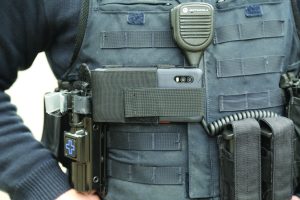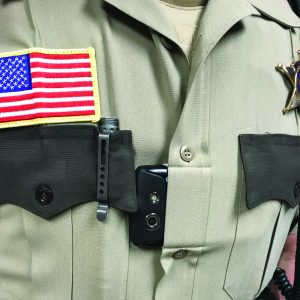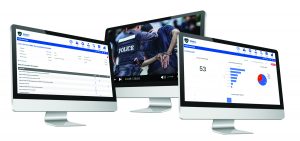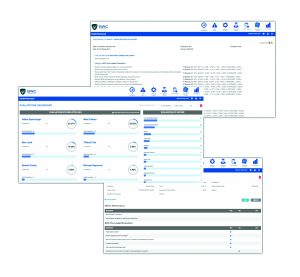Transparency and accountability. Two of the hottest topics in modern policing have roots in Sir Robert Peel’s policing principles.1
For law enforcement officers to fight crime effectively, they must build and maintain community trust and confidence in their actions. The right tools and technology can help them in this endeavor.
Body-Worn Cameras

Propelled by highly publicized events in the early 2010s, body-worn cameras (BWCs) have been rapidly adopted and touted as the solution to increase police legitimacy. BWCs are believed to reduce unjustified use of force by police, promote accountability for police misconduct, discourage unfounded or frivolous complaints against police, and improve community-police interactions overall.2 However, the intended transparency and accountability benefits can be missed without a proper review and auditing process. While BWCs seem to have support among officers and the public, studies have shown that the earliest versions of these devices fell short of the original expectations.3 Luckily, technology companies consistently survey officers using their products to rectify this issue, enhancing the hardware and software to make them more effective in the field.
Software

The most traditional BWCs come in the form of a hardware device. However, the California-based company Visual Labs provides an alternative. “We call ourselves the body camera company that does not make body cameras,” said Chief Operating Officer, Alexander Popof.4 The difference with the Visual Labs system is that there is no hardware solution; the BWC is sold as a software license.
What originally started as a senior project from the computer science department at Stanford exploring the capabilities of livestreaming video evolved into the Visual Labs Smartphone Body Camera Software. With this license, agencies are able to place the Visual Labs application onto any Android smartphone. The phone then receives all the capabilities and technical security features of a proprietary hardware device. This allows an agency to use the device as a hands-free body-worn camera, but it still acts as a functioning phone, allowing for digital photographs, audio recordings, and text messaging.

Although some phones have programmable buttons for recording activation, Visual Labs offers a Bluetooth activation button. It is about the size of a quarter and can be placed in a pocket, on a keychain, or on a vest for easy access. Rather than touching the phone, officers can tap the button to begin recording. Automatic triggers and remote activation are additional options. As soon as a photograph, audio recording, or standard body camera recording is taken, a digital fingerprint is created, and the file is encrypted immediately. When the device has connectivity, the file will be automatically uploaded to the Visual Labs digital management platform. This means that, following the Criminal Justice Information Services’ requirements, the file is encrypted at rest, as well as transported along an encrypted connection.
A software solution by Equature places a focus on the audio and video files. A full-service provider for law enforcement, Equature offers a host of platforms that encompass every aspect of a call for service. From caller to dispatcher to officer, “it’s a joint collaboration between law enforcement and the community when you put Equature product together,” said Chris Quayle, vice president of business development.5
The cloud-based platform, Viewpoint 2 Suite, is host to various artificial intelligence–based solutions that allow agencies to manage, redact, search, and share critical evidence. One solution, Equature Studio, allows real-time, automated redaction and transcription of an audio or video file from 911 calls, BWC videos, radio transmissions, and many other sources. Within minutes (if not seconds), the software recognizes individuals and tracks them for redaction while transcribing the audio. A short summary of the file can also be processed. Manual functions such as editing and notating are available.
The open architecture design allows agencies to use the software with audio and file types from devices that are not a proprietary Equature device. The user needs only to manually input the BWC footage into the system.
Hardware
Over the past 18 years, Digital Ally has built products to reflect their customers’ needs. In 2009, they announced the original FirstVu body camera. A revolution in the law enforcement industry, the BWC offered an interactive screen to view and tag videos. Now, the original camera has evolved into the FirstVu PRO, which has the same touchscreen and infield tagging concept but is far more feature rich and user friendly. The FirstVu PRO features live GPS tracking, remote activation, and an “S.O.S. officer down” button, along with many additional capabilities.
“Just like most cameras, a record button is the most common way to activate and stop a recording,” explained Katie James, sales implementation manager at Digital Ally. “With the FirstVu PRO, we take activating a recording a little further.”6 Digital Ally has patented and released a wireless activation via Wi-Fi and cloud. Other activation methods are through dispatch remote back-office activation or geo-fencing.
While recording in the field, officers can swap a battery without stopping a recording. The FirstVu PRO can also communicate between multiple devices that are in use. When the recording is complete, a user will be prompted to enter key information so that, when the audio or video is uploaded to the cloud, searchable information and retention periods are applied.
Equature also provides the field with a BWC hardware solution, Equature Armor, through select mobile devices. With GPS location and livestreaming video and audio capabilities, officers and command centers can see and hear emergency calls as they occur.
Internal Affairs
Once an agency has a BWC solution in place, the next step is to look at how leadership is going to ensure that officers are adhering to policy, procedures, and customer service expectations in the field. Because command staff can often be spread too thin and there is a plethora of data to review, an agency’s audit process can be cumbersome and time-consuming with many videos going unreviewed. There are software companies that have created alternative methods to help.
[The] audit process can be cumbersome and time-consuming with many videos going unreviewed.
Truleo provides a desktop application that integrates with Axon, Motorola, and Lenslock cameras. “It is truly designed to turn body camera videos into an asset for training,” explained Truleo’s cofounder and CEO, Anthony Tassone.7 A Truleo machine connects to the secure environments through a department-approved API and begins to transcribe and analyze the videos in near real time. The machine then puts the finished insights into a department-owned, secure database and provides a “virtual sergeant” to visualize the insights and run complex queries.
Truleo’s artificial intelligence scans 100 percent of body-worn camera videos and surfaces highly professional interactions. Any unprofessional behavior, such as insults, threats, or profanity, is also identified. The command staff can analyze the flagged behavior to determine if the officer acted against policy.

When agencies are unable to review all collected data, problematic behaviors can get missed. Therefore, when a complaint is filed, there is more of an emphasis on being reactive rather than proactive. “What most departments do is an audit on a complaint that came in,” said Ben Laird, president of Frontline Public Safety Solutions. “So now [an agency] is reviewing a problem when it’s possibly something that could’ve been avoided if they were doing random reviews.”8
Frontline Public Safety Solutions has developed a unique cloud-based software that removes obstacles from the process of random reviews. This is accomplished through the BWC Audit Software’s capability to randomize calls. In other words, the platform tells command staff which calls to pull for review. Once pulled from the camera log, the supervisor answers a variety of questions that have been customized prior to the evaluation, identifying if proper tactics are used or appropriate actions and behaviors are exhibited by the officer wearing the BWC. The reviews are then sent along the chain of command for acknowledgement.

By utilizing this auditing software, supervisors can give integral feedback to employees on their performance and suggest targeted training for any problematic behaviors. The company also acknowledged that the analytics-based reports can be shared with the public as a visualization tool to ensure the department’s—and the community’s—standards are being met. These features, as well as access to each of Frontline Public Safety Solutions’ eight platforms, are available through the company’s MyFrontline dashboard.
In recent years, BWCs have been rapidly adopted across the law enforcement field, and there are now many types from which to choose to best suit an agency’s needs. However, the intended transparency and accountability benefits come only when there is a proper review and auditing process to accompany their use.d
Notes:
1San Jose Police Department, “Sir Robert Peel’s Principles of Law Enforcement.”
2Cynthia Lum and Christopher S. Koper, “The Evidence Base for Body-Worn Cameras: What Law Enforcement Leaders Still Need to Know,” Research in Brief, Police Chief Online, December 28, 2018.
3Cynthia Lum et al., “Research on Body-Worn Cameras: What We Know, What We Need to Know,” Criminology & Public Policy 18, no. 1 (February 2019): 93–118.
4Alexander Popof (chief operating officer, Visual Labs Inc.) phone interview, February 22, 2023.
5Chris Quayle (vice president of business development, Equature) phone interview, February 16, 2023.
6Katie James (sales implementation manager, Digital Ally) email interview, February 26, 2023.
7Anthony Tassone (cofounder and CEO, Truleo) email interview, February 26, 2023.
8Ben Laird (president, Frontline Public Safety Solutions) phone interview, February 23, 2023.
|
SOURCE LIST Please click on the companies’ names to go to their websites. |
||
|
|
||
Please cite as:
“Gaining Trust Through Cameras,” Product Feature, Police Chief 90, no. 4 (2023): 100-102.


